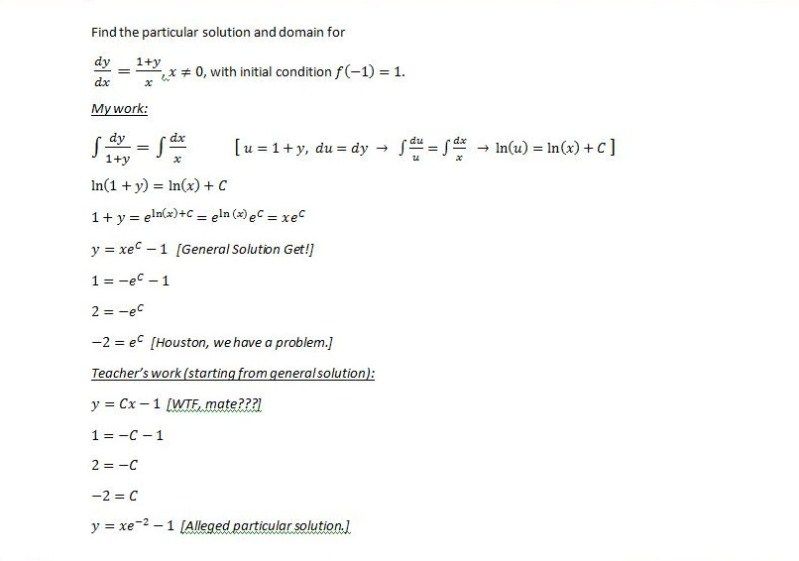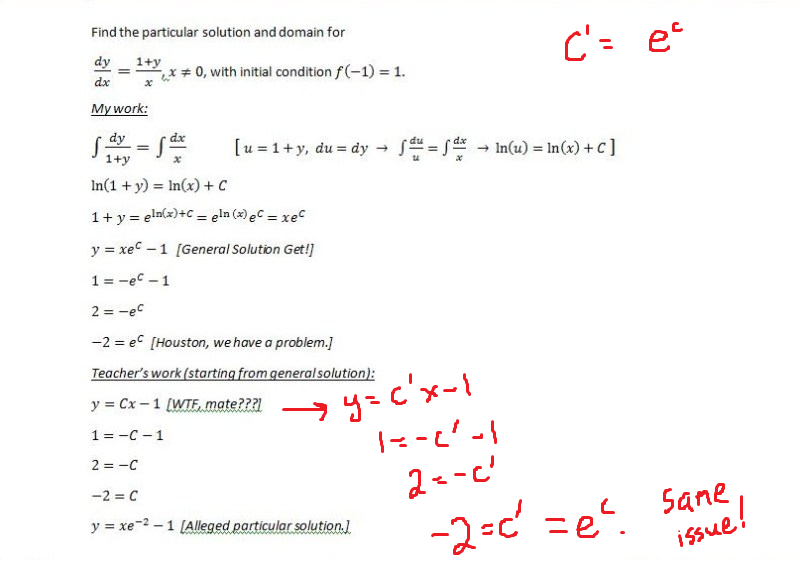Page 1 of 1
Stumped on a Calc 1 Problem
Posted: Sat Apr 28, 2012 12:27 pm
by CaptHayfever
One of my tutoring clients was assigned a packet of AP practice problems. We were working through it with no trouble until this happened:

As you can see, we got the general solution just fine, but hit a road-block when a power of a positive number (e) somehow was negative. I had the kid talk to the teacher about it, & the teacher's work to find the constant is shown. I'd like to know, though, how on earth does e^C = C ?
And remember, "I'm-a Luigi, number one!"
Posted: Sat Apr 28, 2012 6:39 pm
by Sim Kid
This is why I hate math. x_X I'd run into this sort of stuff all the time.
Posted: Sat Apr 28, 2012 7:09 pm
by Deku Tree
Imaginary numbers? c=ln(-2)? Oh, but then the given particular solution looks wrong. Should be y=-2x-1.
Posted: Sun Apr 29, 2012 2:49 am
by CaptHayfever
That's exactly the thing: I've taken freaking graduate-level complex analysis, & I've NEVER learned how to find imaginary logs; how the hell is it on the calc 1 AP test?
The teacher never actually wrote out her particular solution (she stopped at C=-2), but since she got the same general solution as I did before her bizarre e^C=C trick, I just plugged her C value.
The important thing here is her bizarre e^C=C trick. What the crap happened?
And remember, "I'm-a Luigi, number one!"
Posted: Sun Apr 29, 2012 12:03 pm
by Deku Tree
Well I think she just said e raised to some constant is a constant, not that it is the same constant. The constant e was raised to was imaginary, but the problem doesn't require you to solve for it.
Posted: Mon Apr 30, 2012 2:04 am
by CaptHayfever
Ah. Hmm. That's profoundly unsatisfying; though I suppose I'd feel better about it if she'd explained that to the kid.
And remember, "I'm-a Luigi, number one!"
Posted: Sun May 06, 2012 4:29 am
by Apollo the Just
Ok, I know this is a bit of a bump, but I just want to clarify that even if your teacher was trying to use the argument that e^c is still equal to a constant, she still did it wrong.
It's completely mathematically sound to say that e^c is equal to some constant, but you have to distinguish the new constant from the one to whose power e is being raised. My professors usually call the new constant, which is equal to e^c, c'. So c'=e^c
Obviously, this is just to show they are both constants. THEY ARE NEVER EQUAL FOR ANY REAL C. So you have c' =/= c, but they are both constants.
Now let's look at your teacher's completely incorrect work.

As you can see, her original statement was just, in that y=(some constant, we call it c', she calls it c)*x - 1. She ends up with 2=-(constant we call c' she calls c).
The PROBLEM is that she goes back and says THAT c, the one we call c', is EQUAL to the c in e^c. Which is horse****.
So actually her work, if she hadn't gotten constants confused, is saying the exact same thing yours is.
So you were right all along; the e^c MUST equal -2. She just went ahead and said that -2=e^(-2) which makes no sense.
tl;dr you were right, the problem doesn't have a real solution, your teacher's solution implies that -2=e^-2 which is dumb
Just thought I'd clarify that you are right
Posted: Tue May 08, 2012 2:24 am
by Deku Tree
If you ever do want to solve for the natural log of a negative number (you know, for fun), all you really need to know are Euler's identity and exponent addition rules. Knowing those, you find out that:
ln(-c)=ln(c)+πi.
Posted: Tue May 08, 2012 3:08 pm
by CaptHayfever
I've always found it interesting how many imaginary results involve pi.
And remember, "I'm-a Luigi, number one!"


